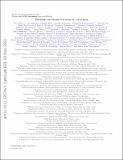TOI-2109: An Ultrahot Gas Giant on a 16 hr Orbit
Author(s)
Seager, Sara
DownloadAccepted version (1.927Mb)
Open Access Policy
Open Access Policy
Creative Commons Attribution-Noncommercial-Share Alike
Terms of use
Metadata
Show full item recordAbstract
We report the discovery of an ultrahot Jupiter with an extremely short orbital period of 0.67247414 ± 0.00000028 days (∼16 hr). The 1.347 ± 0.047 RJup planet, initially identified by the Transiting Exoplanet Survey Satellite (TESS) mission, orbits TOI-2109 (TIC 392476080)—a Teff ∼ 6500 K F-type star with a mass of 1.447 ± 0.077 M☉, a radius of 1.698 ± 0.060 R☉, and a rotational velocity of $v\sin {i}_{* }=81.9\pm 1.7$ km s−1. The planetary nature of TOI-2109b was confirmed through radial-velocity measurements, which yielded a planet mass of 5.02 ± 0.75 MJup. Analysis of the Doppler shadow in spectroscopic transit observations indicates a well-aligned system, with a sky-projected obliquity of λ = 1fdg7 ± 1fdg7. From the TESS full-orbit light curve, we measured a secondary eclipse depth of 731 ± 46 ppm, as well as phase-curve variations from the planet's longitudinal brightness modulation and ellipsoidal distortion of the host star. Combining the TESS-band occultation measurement with a Ks-band secondary eclipse depth (2012 ± 80 ppm) derived from ground-based observations, we find that the dayside emission of TOI-2109b is consistent with a brightness temperature of 3631 ± 69 K, making it the second hottest exoplanet hitherto discovered. By virtue of its extreme irradiation and strong planet–star gravitational interaction, TOI-2109b is an exceptionally promising target for intensive follow-up studies using current and near-future telescope facilities to probe for orbital decay, detect tidally driven atmospheric escape, and assess the impacts of H2 dissociation and recombination on the global heat transport.
Date issued
2021Department
Massachusetts Institute of Technology. Department of Earth, Atmospheric, and Planetary SciencesJournal
Astronomical Journal
Publisher
American Astronomical Society
Citation
Seager, Sara. 2021. "TOI-2109: An Ultrahot Gas Giant on a 16 hr Orbit." Astronomical Journal, 162 (6).
Version: Author's final manuscript